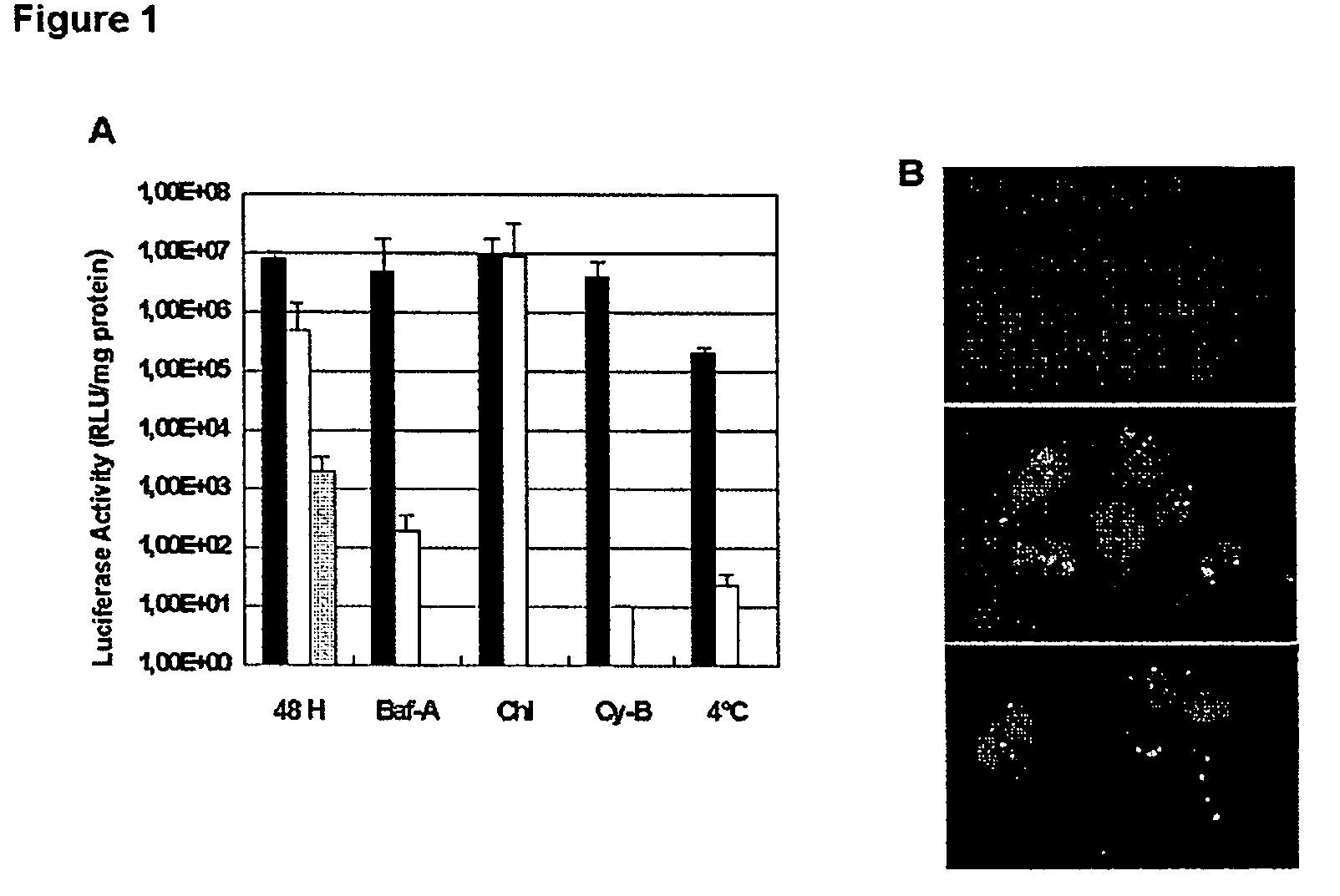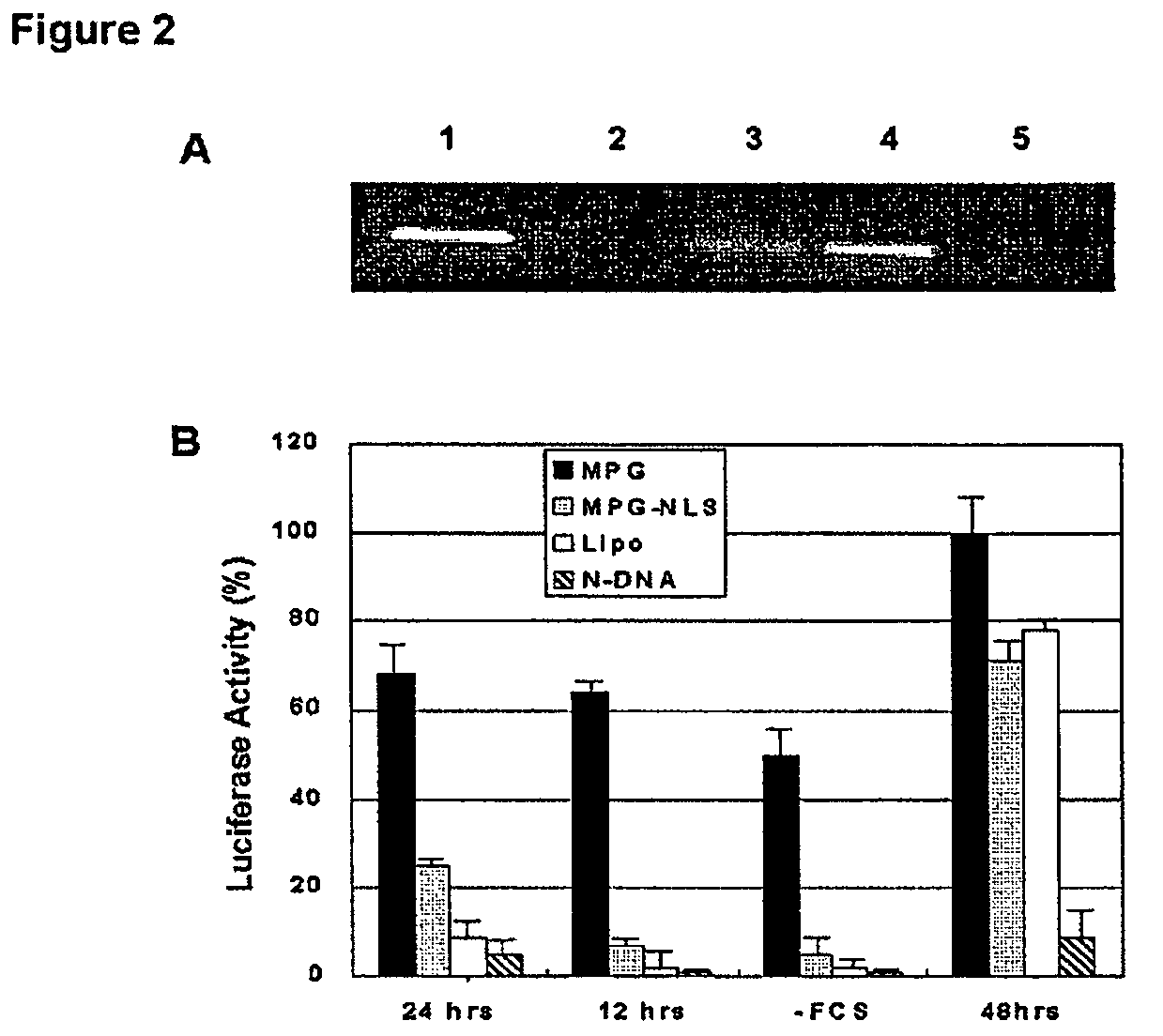Peptide carrier for delivering siRNA into mammalian cells
a technology of peptide carriers and mammalian cells, which is applied in the direction of peptides/protein ingredients, drug compositions, peptides, etc., can solve the problems of poor ability to escape from the endosomal compartment, non-viral based gene delivery systems, and limited interest in non-viral synthetic gene delivery systems for therapeutic applications
- Summary
- Abstract
- Description
- Claims
- Application Information
AI Technical Summary
Benefits of technology
Problems solved by technology
Method used
Image
Examples
example 2
MPG-Mediated siRNA Targeting Luciferase Delivery
[0046]1. Material and Methods
[0047]Cell Culture and MPG-Mediated Transfection.
[0048]Hs68 (ATCC n°CRL-1635), Cos-7 (ATCC n°CRL-1651) and HeLa (ATCC n°CCL-2) cell lines were cultured in Dulbecco's Modified Eagle's Medium supplemented with 2 mM glutamine, 1% antibiotics (streptomycin 10 000 μg / ml, penicillin, 10'000 IU / ml) and 10% (w / v) fetal calf serum (FCS) at 37° C. in a humidified atmosphere containing 5% CO2 as described previously (18). For MPG or MPGΔNLS-mediated gene delivery, peptide carrier / siRNA complexes were formed in DMEM or PBS, at a charge ratio 10:1 and incubated for 30 min at 37° C. Cells grown to 60% confluence were then overlaid with these preformed complexes. After 30 min incubation at 37° C., 1 ml of fresh DMEM supplemented with 10% fetal calf serum was added to the cells, without removing the overlay of carrier / siRNA, and cells were returned to the incubator.
[0049]Transfections were performed for 1 hour, after which...
example 3
MPG-Mediated Gene Delivery is Independent of the Endosomal Pathway
[0057]1. Material and Methods
[0058]Cell Culture and MPG-Mediated Transfection.
[0059]Hs68, Cos-7 and HeLa cell lines were cultured in Dulbecco's Modified Eagle's Medium supplemented with 2 mM glutamine, 1% antibiotics (streptomycin 10 000 μg / ml, penicillin, 10'000 IU / ml) and 10% (w / v) fetal calf serum (FCS) at 37° C. in a humidified atmosphere containing 5% CO2 as described previously (18). For MPG or MPGΔNLS-mediated gene delivery, peptide carrier / DNA complexes were formed in DMEM or PBS (500 μl of DMEM containing 100 ng of DNA complexed with MPG at a charge ratio 5:1) and incubated for 30 min at 37° C. Cells grown to 60% confluence were then overlaid with these preformed complexes. After 30 min incubation at 37° C., 1 ml of fresh DMEM supplemented with 10% fetal calf serum was added to the cells, without removing the overlay of carrier / DNA, and cells were returned to the incubator.
[0060]For cell cycle-dependent studi...
example 4
Role of the NLS of MPG in Nuclear Targeting of Plasmids
[0064]1. Material and Methods
[0065]Protein Preparation:
[0066]Plasmids for the expression of recombinant GST-fusion protein importin a and importin β were kindly provided by B. Cullen. Proteins were purified as described previously (13). For affinity chromatography experiments, protein GST-importin α and importin-β were coupled onto GST-bead in 150 mM NaCl, 1 mM EDTA and 10 mM Hepes pH 7.5. Importin-coupled beads were then incubated in batch with MPG / DNA complexes for 1 hr, extensively washed and incubated with 50 nM glutathione to elute the complexes. DNA was then extracted from the complexes with phenol-chloroform, followed by ethanol precipitation, and finally analyzed by agarose gel electrophoresis (0.8%).
[0067]2. Results
[0068]MPG peptide is derived from the nuclear localization sequence of the SV 40 large T antigen and from the fusion peptide domain of HIV-1 gp41 protein (17). Lysine residues are required for the formation o...
PUM
| Property | Measurement | Unit |
|---|---|---|
| volume | aaaaa | aaaaa |
| volume | aaaaa | aaaaa |
| molar ratio | aaaaa | aaaaa |
Abstract
Description
Claims
Application Information
 Login to View More
Login to View More - R&D
- Intellectual Property
- Life Sciences
- Materials
- Tech Scout
- Unparalleled Data Quality
- Higher Quality Content
- 60% Fewer Hallucinations
Browse by: Latest US Patents, China's latest patents, Technical Efficacy Thesaurus, Application Domain, Technology Topic, Popular Technical Reports.
© 2025 PatSnap. All rights reserved.Legal|Privacy policy|Modern Slavery Act Transparency Statement|Sitemap|About US| Contact US: help@patsnap.com



